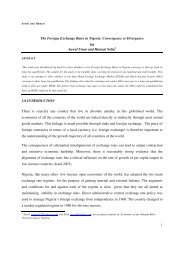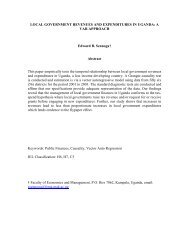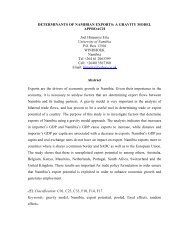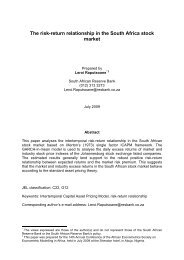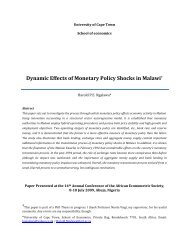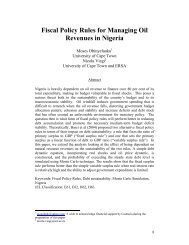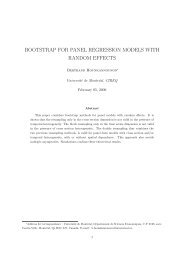Explaining Polarization and its Dimensions in Nigeria - African ...
Explaining Polarization and its Dimensions in Nigeria - African ...
Explaining Polarization and its Dimensions in Nigeria - African ...
Create successful ePaper yourself
Turn your PDF publications into a flip-book with our unique Google optimized e-Paper software.
the disjo<strong>in</strong>t supports, should <strong>in</strong>crease polarization. This is to say that a symmetric outward slide<br />
will <strong>in</strong>crease polarization.<br />
Axiom 4: Given two distributions F <strong>and</strong> G, if P(F)≥P(G), P(G), be<strong>in</strong>g P(F) <strong>and</strong> P(G) the<br />
respective polarization <strong>in</strong>dexes, it must be that P(αF)≥P(αG) where αF <strong>and</strong> αG represent a<br />
rescaled version of F <strong>and</strong> G. This states that if one situation exhib<strong>its</strong> greater polarization than<br />
another, it must cont<strong>in</strong>ue to do so when populations <strong>in</strong> both situations are scaled up or down by<br />
the same amount, leav<strong>in</strong>g all (relative) distributions unchanged (Duclos et al. 2004).<br />
Estimation method<br />
As <strong>in</strong> ER, effective antagonism of an <strong>in</strong>dividual with <strong>in</strong>come x towards another person of <strong>in</strong>come<br />
y (under f ) could be written as T(i,a) where i = f(x) <strong>and</strong> a = |x − y|. It is assumed that T is<br />
<strong>in</strong>creas<strong>in</strong>g <strong>in</strong> <strong>its</strong> second argument <strong>and</strong> that T(i,0) = t(0,a) = 0, just as <strong>in</strong> ER. Here, polarization is<br />
proportional to the “sum” of all effective antagonisms written as:<br />
PF ( ) = ∫∫ T( f ( x), x−<br />
y) f( x) f( y)<br />
dxdy<br />
(2)<br />
DER establish that a general polarization measure P, as described <strong>in</strong> (6), satisfies axiom 1-4 of<br />
polarization if <strong>and</strong> only if it is proportional to<br />
1+<br />
α<br />
Pα<br />
( f ) ≡∫∫ f ( x) f ( y) y −x dydx,<br />
(3)<br />
whereα<br />
[.25,1]<br />
Concerns about estimat<strong>in</strong>g procedure <strong>and</strong> associated statistical <strong>in</strong>ference follow DER approach<br />
which first remark that for every distribution function F with associated density f <strong>and</strong> mean µ,<br />
we have P ( F) f( y) α<br />
α<br />
=∫ a( y) dF( y)<br />
, (4)<br />
10



